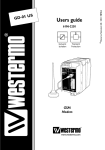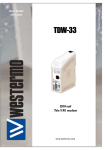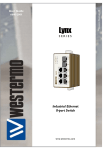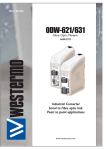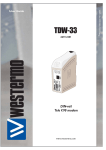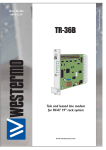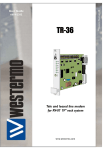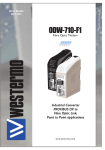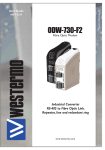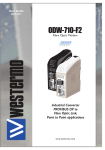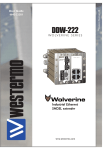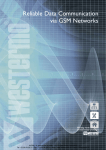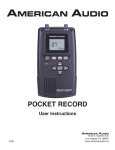Download Westermo EDW-100 User guide
Transcript
6616-2202 EDW-100 Serial Adapter www.westermo.com © Westermo Teleindustri AB • 2007 User Guide Safety ! Before installation: Read this manual completely and gather all information on the unit. Make sure that you understand it fully. Check that your application does not exceed the safe operating specifications for this unit. This unit should only be installed by qualified personnel. This unit should be built-in to an apparatus cabinet, or similar, where access is restricted to service personnel only. The power supply wiring must be sufficiently fused, and if necessary it must be possible to disconnect manually from the power supply. Ensure compliance to national installation regulations. This unit uses convection cooling. To avoid obstructing the airflow around the unit, follow the spacing recommendations (see Cooling section). ! Before mounting, using or removing this unit: Prevent access to hazardous voltage by disconnecting the unit from power supply and all other electrical connections. Warning! Do not open connected unit. Hazardous voltage may occur within this unit when connected to power supply or TNV circuits. Maintenance No maintenance is required, as long as the unit is used as intended within the specified conditions. 2 6616-2202 Introduction The EDW-100 is an Industrial Ethernet to serial adapter or Ethernet Terminal Server. The serial interface is selectable between RS-232 and RS-422/485. The Ethernet interface is 10/100BASE-T and supports the following networking protocols: TCP, UDP, ICMP, IGMP, HTTP, ARP. Two EDW-100 can be used to provide a serial point to point link over an Ethernet network using either UDP or TCP. When using TCP the EDW-100 can be configured as client or server. In addition to a transparent serial point-to-point link and ethernet to serial adapter, the EDW-100 MG can also be configured to act as a Modbus gateway. Network Serial Device Configured as UDP- or TCP-server Configured as UDP- or TCP-client Serial Device Serial Slave Network Broadcast Multicast Serial Slave Serial Master Each unit passes data from its serial interface to the serial interface of the other unit. This enables long distance serial communication using pre-existing networks. When EDW-100 is used with the UDP protocol it is also possible to communicate one to many (e.g. master to multiple slaves), by using a broadcast address or multicast addressing Serial Slave Network Interface Application software COM port redirector software Data to / from COM3 Data to / from COM4 Data to / from COM5 Data to / from COM255 Network COM3 COM255 COM4 6616-2202 COM5 EDW-100 can also provide a remote serial interface for a computer connected through a TCP/IP network using a comport redirection software. A COM port redirector or customer written software can be used to create virtual COM ports. This software will redirect data, originally sent to a local COM port, to the remote serial interface of the EDW-100. No changes are required on the computer application software. 3 For more information on applications and technical data visit www.westermo.com. The Web tool also includes an integrated help where all functions and modes are described in details. More help can be found inside the web tool and the "?" button on each configuration page. Agency approvals and standards compliance Type EMC Safety 4 Approval / Compliance EN 61000-6-2, Immunity industrial environments EN 61000-6-4, Emission industrial environments EN 55024, Immunity IT equipment EN 50121-4, Railway signalling and telecommunications apparatus IEC 62236-4, Railway signalling and telecommunications apparatus EN 60950, IT equipment 6616-2202 Declaration of Conformity Westermo Teleindustri AB Declaration of conformity The manufacturer Westermo Teleindustri AB SE-640 40 Stora Sundby, Sweden Herewith declares that the product(s) Type of product Model Art no Installation manual DIN-rail DIN-rail EDW-100 EDW-120 3616-0020 3616-0010 4500-0112, 6616-2011 4500-0112, 6616-2221 is in conformity with the following EC directive(s). No Short name 89/336/EEG 73/23/EEG Electromagnetic Compatibility (EMC) Low Voltage Directive - LVD References of standards applied for this EC declaration of conformity. No Title Issue EN 61000-6-2 EN 61000-6-1 Immunity for industrial environments Immunity for residential, commercial and lightindustrial environments Information technology equipment – Immunity Emission standard for residential, commercial and light-industrial environments Safety of information technology equipment 2 (2001) 1 (2001) EN 55024 EN 61000-6-3 EN 60950 The last two digits of the year in which the CE marking was affixed: 1 (1998) 1 (2001) 6 (2000) 06 Herewith declares that product(s) listed above is in conformity with No Title Issue FCC part 15 EN 50121-4 IEC 62236-4 Radio frequency devices Railway signalling and telecommunications apparatus Railway signalling and telecommunications apparatus 1 (2003) 1 (2000) 1 (2003) Hans Levin Technical Manager 18th April 2006 Postadress/Postal address Tel. Telefax Postgiro Bankgiro Org.nr/ Corp. identity number Registered office S-640 40 Stora Sundby 016-428000 016-428001 52 72 79-4 5671-5550 556361-2604 Eskilstuna Sweden Int+46 16428000 Int+46 16428001 6616-2202 5 Type tests and environmental conditions Electromagnetic Compatibility Phenomena Test ESD EN 61000-4-2 RF field AM modulated IEC 61000-4-3 RF field 900 MHz Fast transient ENV 50204 EN 61000-4-4 Surge EN 61000-4-5 RF conducted EN 61000-4-6 Power frequency magnetic field Pulse magnetic field Voltage dips and interruption EN 61000-4-8 Test levels ± 6 kV ± 8 kV 10 V/m 80% AM (1 kHz), 80 – 1 000 MHz 20 V/m 80% AM (1 kHz), 800 – 960 MHz 20 V/m 80% AM (1 kHz), 1 400 – 2 000 MHz Enclosure 20 V/m pulse modulated 200 Hz, 900 ± 5 MHz Signal ports ± 2 kV Power ports ± 2 kV Signal ports unbalanced ± 2 kV line to earth, ± 2 kV line to line Signal ports balanced ± 2 kV line to earth, ± 1 kV line to line Power ports ± 2 kV line to earth, ± 2 kV line to line Signal ports 10 V 80% AM (1 kHz), 0.15 – 80 MHz Power ports 10 V 80% AM (1 kHz), 0.15 – 80 MHz Enclosure 100 A/m, 50 Hz, 16.7 Hz & 0 Hz EN 61000-4-9 EN 61000-4-11 Enclosure AC power ports Radiated emission EN 55022 Conducted emission EN 55022 EN 55022 Dielectric strength EN 60950 Environmental Phenomena Temperature Test Humidity Enclosure AC power ports DC power ports Signal port to other isolated ports Power port to other isolated ports Description Operating Storage & Transport Operating Storage & Transport Operating Operating Operating Altitude Service life Vibration IEC 60068-2-6 Shock IEC 60068-2-27 Operating Packaging Enclosure UL 94 Dimension WxHxD Weight Degree of protection IEC 529 Cooling Mounting 6 Description Enclosure contact Enclosure air Enclosure PC / ABS Enclosure 100 A/m, 6.4 / 16 ms pulse 10 & 5 000 ms, interruption 10 & 500 ms, 30% reduction 100 & 1 000 ms, 60% reduction Class A Class B Class B 2 kVrms 50 Hz 1 min 3 kVrms 50 Hz 1 min 2 kVrms 50 Hz 1 min (@ rated power <60 V) Level –25 to +70ºC –40 to +70ºC 5 to 95% relative humidity 5 to 95% relative humidity 2 000 m / 70 kPa 10 year 7.5 mm, 5 – 8 Hz 2 g, 8 – 500 Hz 15 g, 11 ms Flammability class V-1 35 x 121 x 121 mm 0.2 kg IP 21 Convection On 35 mm DIN-rail 6616-2202 Product description The EDW-100 is an industrial Ethernet to serial interface adapter designed for harsh environments. It allows serial devices to interface through a new or existing Ethernet network. The unit can support either RS-232, RS-485 or RS-422 based protocols running at up to 115.2 kbit/s. Ethernet connection is via a standard RJ-45 port with MDI/MDI-X. The protocols used for network communication is UDP or TCP. This allows the EDW100 to be setup as a TCP-server or -client as well as an UDP unit. Configuration of the unit The EDW-100 can be easly configured via the onboard Web based configuration tool, alternatively some functions can also be set by hardware DIP-switches on the PCB. The network interface properties such as speed, duplex and auto-negotiation can be configured by the Web based configuration tool or by hardware DIP-switches. It is also possible to monitor and override the hardware settings by using the Web tool, if that is done this is indicated by the RC LED (Remotely Controlled). The serial port properties such as data rate, flow control and data bits etc. are configured by the Web based configuration tool. 6616-2202 7 Termination and fail-safe of the RS-422/485 serial interface can only be made by DIP-switches only. The local IP address of the unit can be configured by using a terminal program. New Connection - Hyper Terminal File Edit View Call Transfer Help 'EDW-100 IP CONFIGURATION' Firmware : 4100-9002 -- Current IP configuration -Local IP address : 169.254.100.100 Gateway address : 169.254.100.1 Subnet Mask address : 255.255.255.0 Press <Return> to select the value shown in braces, or enter a new value. Local IP address [169.254.100.100]? Connected 0:01:33 VT100 9600 8-N-1 SCROLL CAPS NUM Capture Print echo Unique features … Packing algorithm that enables the user to decide how and when the serial data should be encapsulated in a TCP or UDP data frame and sent out on the network. … Galvanic isolation, this feature eliminate communication errors. One of the most common errors is caused by potential differences between interconnected equipment. … Redundant power supply with wide input range. Theses feature along with the high EMC immunity enables the device to be used in projects where a high degree of reliability is required. 8 6616-2202 Diagnostic information The first level of diagnostic information is the status indicated by the LED´s. C:\WINDOWS\System32\telnet.exe Westermo EDW-100 login: edw100 Password: ****** Hello edw100 Welcome to Westermo EDW-100 diagnostics service (TCP Server): Listening for TCP connection on port: [9000]... The Telnet diagnostic service provide the user with information such as UDP- or TCP mode, connected or listening state (TCP) etc. 6616-2202 9 Getting started IP Address The default IP address of the EDW-100 when delivered is 169.254.100.100. Default port 9000 Default gateway 169.254.100.1 IP address configuration The IP address is configurable by the Web tool and/or by using a terminal program. Below is an description of how to configure the IP address by using a terminal program. 1. If the address is known, connect the unit from a Web browser with the address to EDW-100. If the address is unknown, connect the serial RS-232 interface to a terminal program with settings: EDW-100 Computer DTE DTE Data rate: 9600 bit/s Data bits: 8 3 3 2 2 Stop bits: 1 7 7 Parity: None 8 8 6 6 Flow control: None 5 5 Note! When connecting EDW-100 to a Comport in a 1 1 4 4 computer you have to use a “Cross-over” cable, 9 9 because both EDW-100 and the computer interface is DTE. 1.8 m standard cable is supported by Westermo art.no. 1211-2172. 2. Setting DIP S1:1 to ‘On’ and power-up the EDW-100 will enable the local IP address to be configured via serial interface. Once connected with the terminal program you can change the IP address, Gateway address and Subnet Mask according to the picture below: New Connection - Hyper Terminal File Edit View Call Transfer Help 'EDW-100 IP CONFIGURATION' Firmware : 4100-9002 -- Current IP configuration -Local IP address : 169.254.100.100 Gateway address : 169.254.100.1 Subnet Mask address : 255.255.255.0 Press <Return> to select the value shown in braces, or enter a new value. Local IP address [169.254.100.100]? Connected 0:01:33 VT100 9600 8-N-1 SCROLL CAPS NUM Capture Print echo See also configuration by Web Tool on page 14 3. Set DIP S1:1 to ‘Off’ and power cycle the EDW-100. 4. The unit is now ready for a complete configuration by the Web tool. Address EDW-100 in a browser with the configured IP address. Note that the used computer have to be on the same 10 6616-2202 Username and Password for configuration The EDW-100 is username and password protected. These are used when connecting with Web browser during configuration and with Telnet for diagnostics. Default username: edw100 Default password: edw100 Browser Login The Webtool has two different login accounts. The first is the EDW-100 Guest account that only allows the user to read the units settings but he has no rights to configure the unit in any way. This accounts Username and Password are fixed and aren’t configurable. EDW-100 Guest Username: guest Password: guest or Username: anonymous Password: anonymous EDW-100 Config The second account is the EDW-100 Config that gives the user rights to configure the unit with new parameter values. This accounts Username and Password can also be configured when the user are logged in as EDW-100 Config. Default Username and Password are listed below. Default Username: edw100 Default Password: edw100 Restore Factory default settings Note! This will clear your customized settings. ON The factory default settings can be restored using DIP-switch S1:2. 1 2 3 4 5 6 7 8 1. Force this to ‘On’ and Power-up the EDW-100 for at least 5 seconds. 2. Force the DIP-switch to ‘Off’ and power cycle the EDW-100. The EDW-100 now contains the factory default settings. Note ! If the default address of the unit is valid on the connected network it is possible to access the unit directly from a browser. 6616-2202 11 Configuration by Web Tool The EDW-100 includes an easy-to-use Web configuration tool. The Web tool is very intuitive and includes useful help information for the configurable parameters. Connect and login to the EDW-100 with the EDW-100 Config account on the default IP address and with default username- and password combination (or your customized if configured) using a standard Web browser. Use the Configuration Wizard to set all parameters then press the button "Program Unit" to write the parameters into the unit or save the Serial/IP® and Telnet Options EDW-100 are bundled with Serial/IP® avertual Com port director software. The Serial/ IP® use portions of the “Telnet Environment Option” (RFC1572) to verify that it is connected to an EDW-100. The EDW-100 has partial support for the “Telnet Com Port Control Option” (RFC2217). This makes it possible to remotely (on the fly) change serial port parameters. Currently supported parameters are baud rate, parity, number of data bits and number of stop bits. As default the Telnet Options are disabled. If the Serial/IP® software is to be used, the Telnet options must med enabled in the web tool. This parameter can be found on the serial page. 12 6616-2202 Diagnostics via Telnet The EDW-100 provides the user with diagnostics information via a Telnet connection on port 23. Information presented to the user is: … Operational mode (UDP, TCP-server or client) … Operational status (Listening for connection (TCP server), connected to host (TCP server or client), Attempting to connect (TCP client)) … The ‘Status’ LED on the EDW-100 will lit during Telnet session. Below is an description of how to start a Windows Telnet session and get diagnostics information from the EDW-100. 1. Start a Telnet session. C:\WINDOWS\System32\telnet.exe Welcome to Microsoft Telnet Client Escape Character is 'CTRL+]' Microsoft Telnet> o 169.254.100.100 2. Connect to EDW-100 by typing ‘o 169.254.100.100’ or the configured IP address of the EDW-100. 3. Login using default username and password (or your customized settings if configured). Application modes The EDW-100 can be setup for use in one of four different application modes: … TCP Server … TCP Client … UDP … Modbus gateway 6616-2202 13 Short description of TCP and UDP User Datagram Protocol (UDP) UDP provides a connectionless datagram service. This means that the arrival of datagram’s or data packets is not controlled and the reliability of the communication is the responsibility of the application layer protocol. In this way UDP is a simpler method of communication than TCP. As data is sent and received without any established connection the data transfer is more efficient and often faster. UDP is therefore used in applications that require efficient use of the bandwidth and also have a higher level protocol to handle lost data. Transmission Control Protocol (TCP) TCP is a connection-oriented delivery service. Connection oriented means that a connection must be established before hosts can exchange data. An acknowledgement is used to verify that the data was received by the other host. For data segments sent, the receiving host must return an acknowledgement (ACK). If an ACK is not received, the data is retransmitted. Flow-control between the hosts is managed by TCP. For larger amounts of data that have to be split between packets TCP provides a method for reliably reassembling the data in the correct order. Because of the requirement to establish a connection and acknowledge transmissions, TCP takes longer time to transmit data than UDP and uses more bandwidth. When delivered the EDW-100 is in TCP server mode. TCP Server mode This mode makes it possible to accept incoming TCP connections attempts to the EDW-100 from an TCP client e.g. a EDW-100 in TCP client mode. Other examples of TCP clients: Telnet client establishing a raw TCP connection, COM-port redirector software running on a Windows PC. TCP Client mode This mode makes it possible to establish a TCP connection to a remote TCP server e.g. a EDW-100 in TCP Server mode. DSR signal rising or a powering up the unit will trigger the EDW-100 to make an connection attempt to the specified server depending on configuration. UDP mode UDP is a connection less protocol sending datagram’s i.e. there are less overhead traffic compared to TCP and no acknowledgement packets will be sent between the peer’s during communication. Using UDP will enable the EDW-100 to send and listen to broadcast- and multicast messages. 14 6616-2202 Short description of Modbus Modbus is a communication protocol developed by Modicon systems. The EDW-100 Modbus gateway is used for interconnecting a TCP/IP Modbus network and a serial line Modbus network (either RTU or ASCII). It permits Modbus clients (masters) on either of the TCP/IP or the serial network to connect to Servers (slaves) on the other network. In a standard Modbus network, there is one master and up to 247 Slaves, each with a unique slave address from 1 to 247. The master can also write information to the slaves. The official Modbus specification can be found at www.modbus-ida.org. Gateway Server mode Allows up to 16 Modbus clients (masters) on a TCP/IP network to connect to servers (slaves) on the serial network. Modbus TCP Client Modbus TCP Modbus RTU or Modbus ASCII Ethernet RS-485 Modbus Slave 1 EDW-100 Modbus Gateway Modbus Slave 2 Modbus TCP Client Up to 16 TCP Clients (Master) Up to 247 servers (Slaves) Modbus Slave 3 Modbus Slave 4 6616-2202 15 Gateway Client mode Allows one Modbus client (master) on a serial network to connect to one or more servers (slaves) on the TCP/IP network. Modbus Slave 5 Modbus TCP Modbus RTU or Modbus ASCII Ethernet RS-485 EDW-100 Modbus gateway Modbus Client Modbus Slave 2 Modbus Slave 6 Max total 247 Servers 1 Client (Master) and up to 247 servers (Slaves) Modbus Slave 3 Modbus Slave 4 Setting up the EDW-100 as a Modbus Gateway Set the EDW-100 application mode to Modbus gateway to enable the gateway functionality. Serial settings and ip-configuration is shared whit the other application mode but the rest of the Modbus configuration is done on the specific Modbus configuration page. To set up the gateway it is necessary to know details about the TCP and the serial Modbus network. Please refer to the web tool help page for more configuration details. 16 6616-2202 Packing algorithm When data arrives at the serial port of the EDW-100 there must be one or more criteria fulfilled to trigger the EDW-100 to encapsulate the received serial data into a frame and send it out on the network. These criteria are setup using different parameters i.e. the ‘packing algorithm’. The default settings are selected to be compatible to most applications but can be optimized to the customer specific application. Detailed description can be received from the Web configuration tool. Conditions Received data Transmitted data Packing Network Advanced settings Advanced settings configure the unit for special application requirements or special interface functions, these settings are default disabled. Detailed description can be received from the Web configuration tool. 6616-2202 17 Interface specifications Power Rated voltage Operating voltage Rated current Rated frequency Maximum inrush current @ 10 ms Polarity Redundant power input Isolation to Connection Connector size 12 to 48 VDC 10 to 60 VDC 250 mA @ 12 VDC 125 mA @ 24 VDC 63 mA @ 48 VDC DC 0.3 A2s @ 48 VDC Reverse polarity protected Yes All other 3 kVrms Detachable screw terminal 0.2 – 2.5 mm2 (AWG 24 – 12) RS-422/485 Electrical specification Data rate Data format Protocol Retiming Turn around time Circuit type Transmission range Settings Protection Isolation to Connection Connector size Shielded cable Conductive housing EIA RS-485 2-wire or 4-wire twisted pair 300 bit/s – 115.2 kbit/s 7 or 8 data bits, Odd, even or none parity, 1 or 2 stop bits Transparent, optimised by packing algorithm Not applicable < 3 bits TNV-1 ≤ 1200 m, depending on data rate and cable type (EIA RS-485) 120 Ω termination and fail-safe biasing 680 Ω Installation Fault Tolerant (up to ±60 V) Power 3 kV Ethernet 1 1.5 k Vrms Detachable screw terminal 0.2 – 2.5 mm2 (AWG 24 – 12) Not required, except when installed in Railway applications as signalling and telecommunications apparatus and located close to rails* No * To minimise the risk of interference, a shielded cable is recommended when the cable is located inside 3 m boundary to the rails and connected to this port. The cable shield should be properly connected (360°) to an earthing point within 1 m from this port. This earthing point should have a low impedance connection to the conductive enclosure of the apparatus cabinet, or similar, where the unit is built-in. This conductive enclosure should be connected to the earthing system of an installation and may be directly connected to the protective earth. 18 6616-2202 RS-232 Electrical specification Data rate Data format Protocol Retiming Circuit type Transmission range Isolation to Connection Shielded cable Conductive housing Number of ports EIA RS-232 300 bit/s – 115.2 kbit/s 7 or 8 data bits, Odd, even or none parity, 1 or 2 stop bits. Transparent, optimised by packing algorithm Not applicable SELV 15 m Power 3 kV Ethernet 1 1.5 kVrms 9-pin D-sub male (DTE) Not required, except when installed in Railway applications as signalling and telecommunications apparatus and located close to rails* Isolated to all other circuits 1 Ethernet Electrical specification Data rate Protocol Duplex Circuit type Transmission range Isolation to Connection Shielded cable Conductive housing IEEE std 802.3. 2000 Edition 10 Mbit/s or 100 Mbit/s, auto-negotiated or manually set by DIP-switches UDP, TCP, ICMP, HTTP and ARP Full- or half duplex, auto-negotiated or manually set by DIP-switches TNV-1 100 m Power 3 kVrms RS-232 1.5 kVrms RS-422/485 1.5 kVrms RJ-45 shielded, auto MDI/MDI-X Not required, except when installed in Railway applications as signalling and telecommunications apparatus and located close to rails* Isolated to all other circuits * To minimise the risk of interference, a shielded cable is recommended when the cable is located inside 3 m boundary to the rails and connected to this port. The cable shield should be properly connected (360°) to an earthing point within 1 m from this port. This earthing point should have a low impedance connection to the conductive enclosure of the apparatus cabinet, or similar, where the unit is built-in. This conductive enclosure should be connected to the earthing system of an installation and may be directly connected to the protective earth. 6616-2202 19 Mounting This unit should be mounted on 35 mm DIN-rail, which is horizontally mounted inside an apparatus cabinet, or similar. Snap on mounting, see figure. CLICK! Cooling This unit uses convection cooling. To avoid obstructing the airflow around the unit, use the following spacing rules. Minimum spacing 25 mm (1.0 inch) above /below and 10 mm (0.4 inches) left /right the unit. Spacing is recommended for the use of unit in full operating temperature range and service life. 10 mm * (0.4 inches) * Spacing (left/right) recommended for full operating temperature range 25 mm 25 mm Removal Press down the black support at the top of the unit. See figure. 20 6616-2202 Connections S1 DIP-switch under lid (for details see page 21) LED indicators, also integrated in the RJ-45 connector. (for details see next page) RS-422/485 interface screw terminal 4-position Direction* No. 1 In Ethernet 1 RJ-45 connection (for details see next page) No. 2 In No. 3 In/Out No. 4 In/Out Description R+ line RS-422 R– line RS-422 T+ line RS-422/485 T– line RS-422/485 * Direction relative this unit S2 DIP-switch Termination (for details see page 21) Power connection screw terminal 4-position No. 1 No. 2 No. 3 No. 4 RS-232 (DTE) 9-position Direction No. 1 N/C No. 2 In No. 3 Out No. 4 Out No. 5 – No. 6 In No. 7 Out No. 8 In No. 9 N/C 6616-2202 Description Not connected (DCD) Received Data (RD) Transmitted Data (TD) Data Terminal Ready (DTR) Signal Ground (SG) Data Set Ready (DSR) Request To Send (RTS) Clear To Send (CTS) Not connected (RI) Description Common +VA +VB Common The EDW-100 supports redundant power connection. The positive input are +VA and +VB, the negative input for both supplies are COM. The power is drawn from the input with the highest voltage. 21 Ethernet Ethernet TX connection (RJ-45 connector), automatic MDI/MDI-X crossover*. Contact 1 2 3 4 5 6 7 8 Shield Signal Name TD+ TD– RD+ RD– Direction In/Out In/Out In/Out In/Out Description/Remark Transmitted/Received Transmitted/Received Transmitted/Received NC NC Transmitted/Received NC NC HF-connected data data data data 8 7 6 5 4 3 2 1 CAT 5 cable is recommended. Unshielded (UTP) or shielded (STP) connector might be used. * Depend of settings on S1; 6, 7 and 8. LED Indicators LED PWR Power TD Status OFF ON OFF Transmit data RD Receive data RTS Request to send CTS Clear to send LINK STAT Status RC Remotely controlled SPD Speed Integrated in RJ-45 Green DPX Duplex Integrated in RJ-45 Yellow 22 ON OFF ON OFF ON OFF ON OFF ON Flash OFF ON OFF ON ON OFF ON OFF Description No internal power Internal Power OK No serial data transmitted from the unit, (RS-232 or RS-422/485) Serial data transmitted from the unit, (RS-232 or RS-422/485) No serial data received to the unit, (RS-232 or RS-422/485) Serial data received to the unit, (RS-232 or RS-422/485) No RTS to the RS-232 interface or RS-422/485 transmitting. RTS to the RS-232 interface or RS-422/485 receiving. No CTS from the RS-232 interface CTS from the RS-232 interface No Ethernet link. Cable not connected. Good Ethernet link. Ethernet data is transmitted or received, traffic indication. Normally Off Telnet session established to Telnet diagnostics service or Ongoing configuration by Web tool DIP switch settings are valid. One or more DIP switches are overrid by remote configuration Ethernet 100 Mbit/s Ethernet 10 Mbit/s Full duplex Half duplex 6616-2202 DIP-switch settings Before DIP-switch settings: ! Prevent damage to internal electronics from electrostatic discharges (ESD) by discharging your body to a grounding point (e.g. use of wrist strap). S1:8 S1:1 S1* DIP-switch ON ON Normally OFF 1 2 3 4 5 6 7 8 ON 1 2 3 4 5 6 7 8 1 2 3 4 5 6 7 8 Enable local IP configure via serial interface. ON ON 1 2 3 4 5 6 7 8 ON Normally OFF 1 2 3 4 5 6 7 8 1 2 3 4 5 6 7 8 ON ON Restore factory default. 1 2 3 4 5 6 7 8 ON 1 2 3 4 5 6 7 8 1 2 3 4 5 6 7 8 Ethernet Auto-negotiation enabled. Auto-crossover enabled. 10 Mbit/s. ON 1 2 3 4 5 6 7 8 Ethernet Auto-negotiation disabled. Auto crossover (MDI/MDIX) disabled. 10 Mbit/s. Ethernet 100 Mbit/s when Autonegotiation disabled Ethernet 10 Mbit/s when Autonegotiation disabled Ethernet Full duplex when Autonegotiation disabled or is not supported. Ethernet Half Duplex Auto-negotiation disabled or is not supported. * DIP switch functions may be override by WEB configuration tool. Override is indicated by RC LED. S1, 3, 4 and 5 not used. Note! DIP-switch alterations are only effective after a power on. A setting configured by any other method during normal operation, possibly overrides the DIP-switch setting. However, an override situation is indicated by the RC LED. S2 Below panel ON 1 2 3 4 ON 1 2 3 4 4-wire termination. 120 ohm 4-wire termination and fail-safe 2-wire termination. 120 ohm 2-wire termination and fail-safe Factory settings S1 ON 1 2 3 4 5 6 7 8 6616-2202 S2 ON 1 2 3 4 23 3.3 V = >1.5 V DIP-switch LED stretch JTAG DEBUG XTAL FLASH 2 MB MAC Data Address CTRL PHY RJ-45 PROCESSOR SDRAM 8 MB Ethernet 1 Power secondary 5 V 5 V = >3.3 V Applications RS-232 CLK RESET I/O XTAL D-sub Power SERIAL CH 1 RS-422/485 I/O Power A Power B Screw terminal Connector Isolation from all other interfaces RS-422/485 general advice 4-wire termination R+ R– T+ T– R– R+ T– T+ R– R+ T– T+ EDW-100 B’ A’ B A =Termination Slave unit Slave unit Slave unit 2-wire termination T+ T– Max 0.3 metre EDW-100 T- T+ T- T+ B A =Termination Slave unit Slave unit Slave unit Termination recommendations The RS-422/485 line must be terminated regardless of the cable length. The termination is ideally placed at the extreme ends of the cable see examples above. The description of the RS-422/485 pin outs will vary between manufactures. For some brands the T+ corresponds to A T- to B, R+ to A´ and R- to B´, but other brands might use some other naming convention. If a unit does not work it can help to swap A and B. If difficulty is being experience contact Westermo for further guidance. 24 6616-2202 One to many using UDP using broadcast or multicast Network Description The one to many function can be used in place of a traditional RS-422 or RS-485 multidrop application. Data entering one of the EDW-100 will be broadcast or Multicast to any other device in the broadcast or multicast group. A typical application would be a SCADA host computer communicating to a number of PLC’s. Point to point using TCP connection, server and client Network 6616-2202 25 Point to point using UDP connection Network Description In a point to point application the EDW-100 can be to replace or extend a cable link. The distance between the EDW-100 units is only limited by the size of the LAN. Data can be sent across the network using ether UDP or TCP. A typical application would be a SCADA or Data logging application interrogating a sensor or PLC. To understand the differences between a UDP and TCP please see page 16–17. Communication one to many using TCP Network Virtual IP IP address:port = Com X IP address:port = Com Y IP address:port = Com Z Description Many legacy software applications do not have any facilities to directly use Ethernet but there is a requirement to use a newly installed or existing LAN to communication to many serial devices. This problem is solved by installing a serial port redirection software on the host PC. The redirection software works by creating virtual serial ports on the computer. The Virtual serial port can be selected and use in the same way as a hardware based port. The serial redirection software will encapsulate the serial data in a TCP/IP and send it to the relevant EDW-100 device. The EDW-100 will then strip off the TCP/IP frame and just forward the serial data to the target device. In th e reverse direction the EDW-100 will encapsulate the data and the serial redirection software will strip off the TCP/IP frame. The serial redirection software can create up to 255 serial comms ports on a single computer. 26 6616-2202 Westermo Teleindustri AB • SE-640 40 Stora Sundby, Sweden Phone +46 16 42 80 00 Fax +46 16 42 80 01 E-mail: [email protected] Westermo Web site: www.westermo.com Westermo Data Communications AB SE-640 40 Stora Sundby Phone: +46 (0)16 42 80 00 Fax: +46 (0)16 42 80 01 [email protected] Westermo OnTime AS Gladsvei 20 0489 Oslo, Norway Phone +47 22 09 03 03 • Fax +47 22 09 03 10 E-mail: [email protected] Westermo Data Communications Ltd Talisman Business Centre • Duncan Road Park Gate, Southampton • SO31 7GA Phone: +44(0)1489 580-585 • Fax.:+44(0)1489 580586 E-Mail: [email protected] Westermo Data Communications GmbH Goethestraße 67, 68753 Waghäusel Tel.: +49(0)7254-95400-0 • Fax.:+49(0)7254-95400-9 E-Mail: [email protected] Westermo Data Communications S.A.R.L. 9 Chemin de Chilly 91160 CHAMPLAN Tél : +33 1 69 10 21 00 • Fax : +33 1 69 10 21 01 E-mail : [email protected] Westermo Data Communications Pte Ltd 2 Soon Wing Road #08-05 Soon Wing Industrial Building Singapore 347893 Phone +65 6743 9801 • Fax +65 6745 0670 E-mail: [email protected] Westermo Teleindustri AB have distributors in several countries, contact us for further information. REV.C 6616-2202 2007.09 Mälartryck AB, Eskilstuna, Sweden Subsidiaries




























